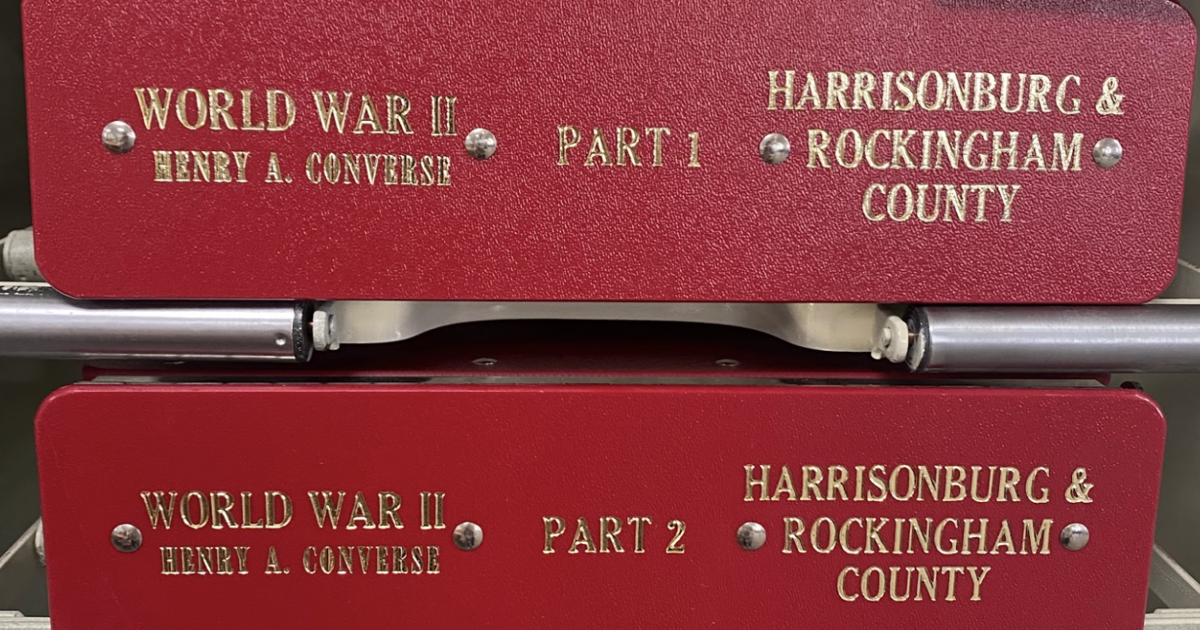When considering wars and conflicts, the Shenandoah Valley is often associated with the American Civil War. Yet the Valley also played a vital role in World War II.
Historian Henry A. Converse explores this in “Harrisonburg and Rockingham County in World War II: Being A Compilation of the Activities of the Citizen-Soldiers and Other Citizens of This Area in Carrying to a Successful Conclusion the War,” published under the supervision of the Virginia World War II History Commission.
The book is available for research in the genealogy section of the Rockingham County Circuit Court Clerk’s Office, and a digital copy is accessible on the court’s genealogy webpage. It is a valuable resource for people interested in both the service members who left home to fight and the civilians who kept the Valley functioning during wartime.
Many of the organizations and individuals Converse described can also be found in the courthouse’s records, which further preserve Rockingham County’s role in the war.
Converse noted that 12.5 percent of the total population of Harrisonburg and Rockingham, or 4,952 of 40,057, served in the armed forces between 1939 and 1945. As stated in the book, that number reflects the records available to him at the time.
Other sources may show different totals today as additional names and records have come to light. This number might have been higher if not for the Valley’s large Mennonite population, who held long-standing convictions against military service.
The Mennonite Church has long taken a stance against direct involvement in military service. A pamphlet distributed at the time, “Peace, War, and Military Service,” outlined the church’s official position. It prohibited its members from buying war bonds or serving in civil organizations allied with the military, as it viewed such activities as too closely tied to the war effort.
John F. Stauffer, president of Eastern Mennonite School, explained that his students were instead “engaged in Civilian Public Service work” and attended Civilian Public Service camps. This included work such as forest fire prevention and trail building. Mennonites had been a distinct presence in the Valley since the early 1700s, when German immigration began, and their response to the war reflected their long-held beliefs.
Other faith communities chose different paths. Catholics, Protestants, and Jewish congregations sent members into military service. They also operated canteens for soldiers and held memorial services for those who lost their lives.
The Red Cross was another vital organization during this time. The Rockingham County chapter was led by women who provided crucial support on the home front. Mrs. Russell Bucher oversaw the production of surgical dressings, hospital garments, relief garments and knitted items for the Army and Navy.
Mrs. Ruth Wampler Clem trained and supervised 40 nurse aides, filling gaps left by shortages of qualified nurses at Rockingham Memorial Hospital. These records of service highlight the critical role local women played during the war years.
The Harrisonburg and Rockingham Chamber of Commerce also adapted to the needs of the moment. Founded in 1916, the Chamber remains a leading business organization to this day.
During World War II, its members worked to maintain the civilian economy, advocated for policies at the state and national levels, and even operated local agencies that had been temporarily abandoned due to wartime shifts.
The Chamber organized delegations to Richmond and Washington, D.C., to ensure Rockingham businesses had access to subcontracting opportunities that supported the war effort. Locally, they pushed for a direct bus line between Harrisonburg and Richmond and ran agencies such as the DMV.
Chamber members themselves also served in the military. At least 36 names are listed in Converse’s book, including Lewis O. Funkhouser, Geo. W. Liskey, John H. Monger, and Clarence W. Wenger. Their service shows how interconnected the home front and battlefront truly were.
Taken together, these stories illustrate how Rockingham County’s wartime experience was built on the contributions of many different people. Churches, schools, hospitals, and businesses all played a part in sustaining the community.
The courthouse’s records help us see these individuals more clearly, whether through enlistment papers, draft registrations, or correspondence preserved in court files. These documents enable families today to trace how their relatives responded to the call to serve in both military and civilian capacities.
Converse’s Harrisonburg and Rockingham County in World War II remains an excellent resource for exploring this history. It highlights both the individuals who went overseas and those who worked tirelessly at home. Paired with the records preserved in the Clerk’s Office, the book offers a fuller understanding of how Harrisonburg and Rockingham County contributed to the war.
Researchers and family historians are encouraged to visit the genealogy section of the courthouse to view the book in person or access the digital copy online at www.rockinghamcountyva.gov/genealogy. The book, along with the court’s extensive collection of military and civilian records, provides insight into how this community came together during one of the most challenging times in world history.
